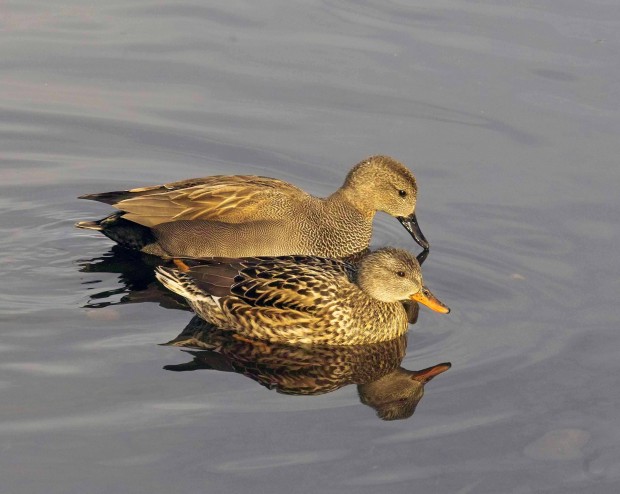Have you ever seen a Gadwall at the Falls of Clyde?
Earlier in the week a local volunteer informed me that he had spotted three female Gadwall on the Clyde, up river from the reserve. Gadwall are quite similar to female Mallard, they are in fact in the same family and can be found next to each other in the bird guide.

There are a few subtle differences though; they are slightly smaller than Mallard, and of slimmer build with narrower wings and body. In flight they have a whitish belly (Mallard pale brownish). The main feature is a small white wing patch or speculum, which can only be found on the adult birds and is less visible on the females. The males have a black stern (bottom) and a pale brown tail. They’re quite grey all over apart from their yellow feet and in flight they have a beautiful chestnut path on their upperwings. The females are the ones you’re most likely to confuse with Mallard but remember they are smaller. They also have a different bill pattern with an orange even stripe along the cutting edges (Mallard is all yellow) and they have darker brown tail feathers.
They breed in eastern central Scotland and other parts of the UK. You can see them anytime of year, but chances are better in winter when numbers increase as birds migrate to spend the winter in the UK, away from harsher continental weather. I can’t say I’ve ever knowingly seen one so I wouldn’t say they were common. There are approximately 1,200 pairs breeding in the UK as opposed to approximately 100,000 pairs of Mallard.
They’re known as dabbling ducks and are surface feeding wildfowl found commonly on lakes, rivers and shallow water. One last fact for you – Gadwall are some of the pirates of the bird world, they like to snatch foods from diving ducks as they surface!
Laura Preston – Falls of Clyde Ranger, Scottish Wildlife Trust
Help support our vital work and join us today!
Help protect Scotland’s wildlife
Our work to save Scotland’s wildlife is made possible thanks to the generosity of our members and supporters.
Join today from just £3 a month to help protect the species you love.
Preface
Earlier in the week a local volunteer informed me that he had spotted three female Gadwall on the Clyde, up river from the reserve. Gadwall are quite similar to female …
